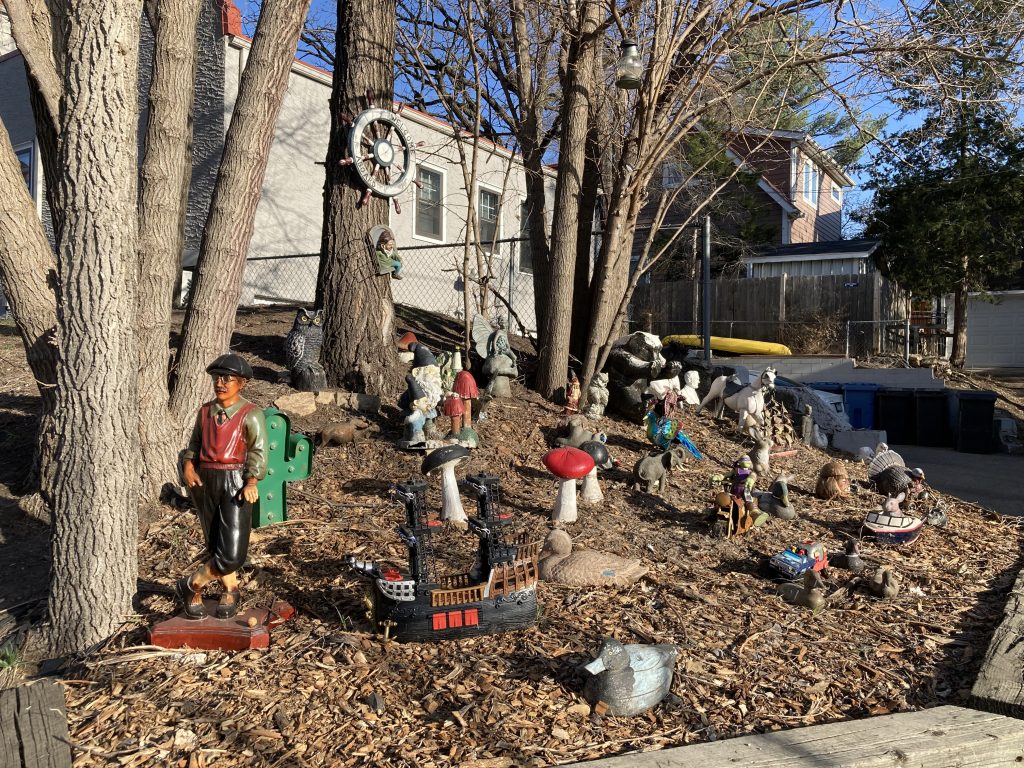4.25 miles
minnehaha falls and back
37 degrees / feels like 32
wind: 21 mph
It snowed most of the day yesterday, only a dusting. Today it’s windy and much colder than a week ago. That wind! My ears ache from it now, sitting at my desk, 20 minutes after finishing.
Difficult to pay attention to anything other than the wind. In the first mile, I started chanting, I am the wind and the wind is invisible. All the leaves tremble, but I am invisible. Then I thought about how I might not be able to see the wind, but I could sure feel it! At that point, I began to wander a little. I’ll try to remember: I can’t see wind, but I believe in it/not seeing is believing/what you see is not what you get/belief/last year’s monthly challenge — wysiwyg
Tried to notice things that moved or sparkled but got distracted. Instead I gave attention to the shadows and thought about contrast — distinct lines, sharp divisions, dark shadows / light pavement, ground, grass
Forgot to look at the river. I bet it was sparkling.
The falls were roaring. The park was crowded. Lots of kids at the playground. An adult playing “hot/cold” with someone. I could hear her calling out, hot! warm warm cold! cold!
Ran on some grit, listened to it sizzle.
Encountered some walkers and runners. I don’t remember seeing any bikers — was that because of all the wind, or did I just forget that I saw them?
For the last mile of the run, I was slowly creeping up on another runner. I tried to slow down so I could keep an even (and far) distance behind him, but I still kept creeping up. Finally, I crossed over to edmund so we were running parallel to each other, divided by the boulevard and the parkway. Within 30 seconds, I passed him.
Tracked the Boston Marathon this morning. Happy that Helen Obiri won and that Emma Bates ran so well. Bummed that Des Linden and Eluid Kipchoge didn’t have great days.
Listened to the rushing wind, yelling kids, sizzling sand, gushing water on the way to the falls. Listened to my swim meet motivation playlist on the way back north.
A. R. Ammonds’ garbage
Onto section 14 today.
the leavings…
anything
thrown out to the chickens will be ground fine
in gizzards or taken underground by beetles and
ants: this will be transmuted into the filigree
of any feelers’ energy vaporizations: chunk and
smear, grease and glob will boil refined in
time’s and guts alembics
alembics = a distilling apparatus used in alchemy
I love the pairing of time and guts here.
on meaningless:
meaningless = a place not meaning yet OR never to mean, which is the emptiness and endlessness of space, the distances of stars OR what to make of so many meanings
it is
fashionable now to mean nothing, not to exist,
because meaning doesn’t hold, and we do not exist
forever; this is forever, we are now in it;
Not sure what to do with this section, except this: I don’t want to try and summarize it. Even as I didn’t grasp everything, I enjoyed reading it, like his references back to earlier parts of the poem, including his love of the baked potato. starch (in Arch) in the potato/meets with my chemistry to enliven by chemistry and the comfort he finds in being free of the complexes of big meaning. And I love his vivid descriptions of breaking down/decomposing. garbage is influencing my writing of my colorblind plate poems, but in slight, slant, off to the side ways.
a final colorblind plate (the 8th)
I have decided that I have one more plate poem to write. It will be about silver and the glitter effect and seeing color as movement and contrast and poetry. Inspired by something I heard on my new favorite show (Escape to the Chateau), I searched “luster” on the Poetry Foundation and found a wonderful poem by another one of my favorite poets, Eamon Grennan. (The line I heard was: Dorothy does glitter, I do luster. It was spoken by mom Angel and refers to her 5 year-old daughter Dorothy. I might have to find room for the differences between glitter and luster in my poem!)
Lark-Luster/ Eamon Grennan
Gravity-defying, the lark in the clear air of a June morning stays aloft on a hoist of song only, and only when song goes as breath gives out does the bird let itself down the blue chute of air in such an aftermath silence so profound you’d think it was a double-life creature: one life aloft in blue, all clarity, the other hidden in the green swaddle of any rocky field out here where, when summer happens, you’d almost see the long silver ribbons of song the bird braids as if binding lit air to earth that is all shadows, to keep us (as we walk our grounded passages down here) alive to what is over our heads—song and silence—and the lot of us leaning up: mind-defeated again, just harking to it.
Oh, that long silver ribbon of song that you can almost see! Love it.
